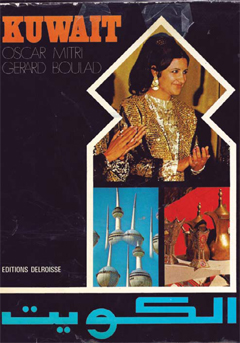 "This land, almost unknown to the West at the beginning of this century, was haunted by three wicked fairies at the dawn of time - the Heat Fairy, the Drought Fairy and the Aridity Fairy. And then, one rainy morning in February 1938, the good Oil Fairy waved her magic wand, and everything changed overnight, and a miracle was accomplished. The miracle is that of the emirate of Kuwait."
"This land, almost unknown to the West at the beginning of this century, was haunted by three wicked fairies at the dawn of time - the Heat Fairy, the Drought Fairy and the Aridity Fairy. And then, one rainy morning in February 1938, the good Oil Fairy waved her magic wand, and everything changed overnight, and a miracle was accomplished. The miracle is that of the emirate of Kuwait."
This passage is not taken from a Disney film script or a fictional children's book. These words were said describing the development of Kuwait in 1975 by Canadian Gerard Boulad and Frenchman Oscar Mitri, two photographers who published a detailed pictorial book punctuated by facts composed in a fictional style that reflected their fascination with the land of Kuwait and its people.
The lensmen came during the reign of Sheikh Sabah Al-Salem Al-Sabah, when the late Sheikh Jaber Al-Ahmad Al-Sabah was the crown prince and prime minister. They documented the period of economic prosperity followed by the discovery of oil. "We realized that this tiny country really is a great one," they wrote.
Pioneer
Kuwait at that time was recognized as a pioneer in building the country and its people. Women were drawn to the field of employment and occupied positions that were once exclusive to men. Boulad and Mitri mentioned that education comprised the largest part of investment, wishing for the world to follow in Kuwait's steps to amend education systems. By the same token, healthcare also was also at its peak. "The problems arising in so-called developed countries in connection with social security, medical treatment and education in general are entirely unknown here," they emphasized.
In addition, the duo provided useful information for tourists, although tourism was new to the country. They highly encouraged tourists to visit Kuwait during the national holidays or Islamic festivals to enjoy traditional celebrations. "Hotels, there are a score of them in Kuwait. And whether they are called Hilton or Sheraton, Mr Smith will still feel at home in them like the residences of California!" they wrote.
The book, simply titled KUWAIT, has 110 color photographs as historical evidence of the country's social, financial, political and ethnic affairs. It's written in three languages - English, French and Arabic. Kuwait Times found another version of the book that appears to contain additional photographs of Kuwait by author/photographer Mitri.
By Athoob A Al-Shuaibi










